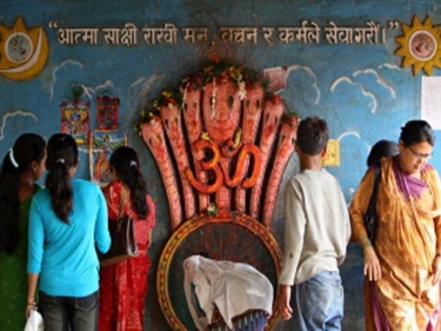 Naga Panchmi is a famous festival all over India. It is a festival when devotees worship either images of or live Nagas (Cobras) on the fifth day (Panchami) of the month of Shravan. Nag Panchmi falls in rainy months of August-September because in this season It is believed that this is the time when snakes come out of their holes that get flooded with rain-water to seek shelter in gardens and many times in houses. So there are increased cases of snake-bites. So, it is believed that to please snakes they are worshipped on this day. from the ancient times India is associated with snake-worship. In India there is community of clans named ‘Nagas’. In Nagas culture snake-worship is very popular. Rituals performed: It is an age-old religious belief that serpents are loved and blessed by Lord Shiv. Lord Shiv wears them as a ornament around his neck. On Naga Panchmi Lord Shiv is also worshipped along with the serpants or pictures of them. To seek immunity from snake bites, they are bathed with milk, haldi-kumkum is sprinkled on their heads and milk and rice are offered as ‘naivedya’. The Brahmin who is called to do the religious ritual is given ‘dakshina’. The Legends: This practice of worshipping the snake on this day is related to the following stories. The Snake and the Farmer A farmer was ploughing his field. At the edge of the field there was an anthill which he inadvertently destroyed with the plough, and thus the young serpents that were hiding in it were killed. The mother snake had casually gone out. When she came back she could not find her young ones. At last she found them cut into pieces. She was furious and understood that the farmer had killed them. She was bent on taking revenge. At night when the farmer was sleeping with his wife and children, the snake came full of anger. She began to bite the feet of the farmer, and then one by one the feet of his wife and children. All began to cry. But the eldest daughter happened to be out of the house that night. Then the snake remembered that on the occasion of her wedding, the girl had gone to the house of her father-in-law. “I will not spare her either,” the snake resolved. The snake ran towards the neighbouring village. She stopped before the door of a house, and saw a young girl inside. She recognized her as the farmer’s eldest daughter. The snake went in determined to bite her. But then she saw the young girl with joint hands worshipping the snake she had made out of “gandh”, and the nine “nagkule” (young snakes). She had offered them “nagane” (gram soaked and parched), “lahya” (rice blown out by parching), and “durva” (grass sacred to Ganpati), and she was praying with great devotion, “O God Snake, don’t be angry if I have committed any mistake. Accept my worship. Look after my people at home and in my father-in-law’s house. Do not bite anyone. Forgive any fault we may have committed inadvertently.” With this the snake was pleased and came before the girl. She opened her eyes and got frightened at the sight of the snake. But the snake said, “Don’t be afraid. I shall not bite you. Tell me who you are and where your house is.” Then the snake knew well that the girl was the farmer’s daughter and felt very sorry for having killed all her people. The snake told the girl what had happened, but told her not to cry. She gave her some nectar and told her to sprinkle it on her dead people, and with this they all came back to life. Krishna and the Kaliya Snake Nag Panchami is also connected with the following legend of Krishna. Young Krishna was playing with the other cowboys, when suddenly the ball got entangled in the high branch of a tree. Krishna volunteered to climb the tree and fetch the ball. But below the tree there was a deep part of the river Yamuna, in which the terrible snake Kaliya was living. Everybody was afraid of that part of the river. Suddenly Krishna fell from the tree into the water. Then that terrible snake came up. But Krishna was ready and jumping on the snake’s head he caught it by the neck. Kaliya understood that Krishna was not an ordinary boy, and that it would not be easy to overcome him. So Kaliya pleaded with Krishna: “Please, do not kill me.” Krishna full of compassion asked the snake to promise that henceforth he would not harass anybody. Then he let the snake go free into the river again. Different ways of celebration: As this is the day of the serpents, devotees pour milk into all the holes in the ground around the house or near the temple to appease them. Sometimes, a small pot of milk with some flowers is placed near the holes so that the snakes may drink it. If a snake actually drinks the milk, it is considered to be extremely lucky for the devotee. The festival is celebrated with much enthusiasm by all, especially women. In different parts on India it is celebrated in many ways. In some parts of southern India, figures of snakes are drawn with red sandalwood paste on wooden boards, or clay images of snakes coloured yellow or black are purchased. These are then worshipped and offered milk. Snake charmers wander about with all sorts of snakes, to which people offer milk. |
Posted By : Vinod Jindal on Mar 02, 2011 |
||
